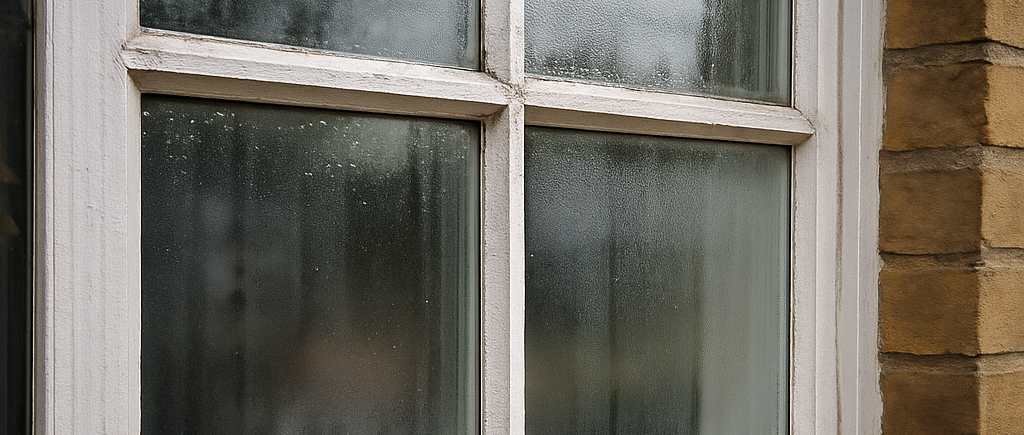Stamford Home Got Condensation? New Windows Might Solve It
If you live in Stamford and find your windows fogging up, don’t panic. You’re not alone.
Condensation on windows is a common issue across Lincolnshire, especially in heritage towns like Stamford where many properties feature older glazing and traditional materials.
While it might look harmless, those misty panes or water droplets on the glass are often the sign of something more serious.
Let’s look at what condensation really means, why it’s such a problem for Stamford homeowners, and why new windows might be the most effective solution.
How to Spot Condensation on Windows
Condensation on windows usually shows up in one of three places: on the inside surface, the outside surface, or between the panes of glass.
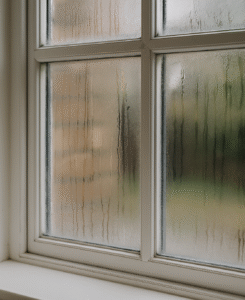
Water droplets forming on the inside of your window panes, especially in the mornings, are a sign of internal condensation. Foggy or misty windows that don’t clear up even when wiped? That’s often condensation between window panes, which means the sealed unit inside your double glazing glass has likely failed.
Condensation on the outside pane (called external condensation) isn’t a problem. In fact, it often means your energy-efficient windows are working well.
You might also notice:
- – Black mould on or around window frames
- – A musty smell, particularly in bedroom windows or corners of rooms
- – Condensation appearing on your kitchen window or bathroom mirror after hot water use
While cold weather and temperature differences make condensation more obvious, it isn’t just a winter problem. Condensation on your windows can occur anytime when moisture-laden air hits the cold surface.
When Is It Time to Act on Window Condensation?
Not all condensation means you need new windows. But knowing when it’s a real problem is key, otherwise you’ll end up with more problems later.
A bit of moisture on your bedroom windows after a cold night isn’t unusual.
But if it’s daily, lingers throughout the day, or appears between panes of glass, that’s a warning sign.
In Stamford’s older homes — especially those with single glazing or wooden frames — even small issues can quickly become bigger ones.
Here are some immediate warning signs that you need to do something about it:
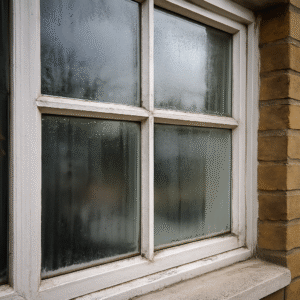
- – Black mould
- – Peeling paint
- – A musty smell around the windows
- – Your windows feel damp to the touch
- – They’re always foggy
Don’t wait until your energy bills rise or your frames start to rot.
Condensation on windows that happens often — especially on newer double-glazed units — shouldn’t be ignored. It affects your home’s energy efficiency, air quality, and even your property value.
The sooner you address the issue, the less likely it is you’ll face costly repairs down the line.
And often, the solution is easier than you think.
If you’re experiencing the symptoms above and think you’re ready to replace you windows, talk to Stamford’s most trusted window company, Aperture Window Group, for honest advice. Simply book a callback in the form below.
What Causes Condensation on Windows?
Condensation is a natural phenomenon, but certain conditions make it worse — especially in Stamford homes where single glazing or badly-fitted windows are still common.
Here are some of the top causes.
1. Poor Ventilation
Many Stamford homes were built before modern ventilation standards were introduced.
Combine that with air-tight seal on older double-glazed windows, and moisture-laden air has nowhere to go.
Lack of air circulation causes humidity levels to rise.
Everyday actions like drying wet clothes, boiling hot water, or even just breathing add extra moisture to the air. Without adequate ventilation, like open air bricks, extractor fans, or trickle vents, you’re likely to see condensation inside windows.
2. Temperature Difference
When the internal temperature of your home is warm, and the outer pane is cool, airborne water vapour condenses on the cold surface.
Stamford’s weather, especially in autumn and winter, causes extreme drops in temperature, making condensation on bedroom windows or bathroom fan vents worse.
3. Broken Seals
Double-glazing units are built with a sealed unit that traps air or gas between the glass panes.
Over time, window seals can fail.
When they do, excess moisture seeps in, leading to misted windows, cloudy windows, and eventually, blown double-glazing.
4. Older or Single-Glazed Windows
Many Lincolnshire homes still feature original windows with single glazing. These offer little thermal efficiency, leading to cold glass and greater heat transfer.
If you’ve got wooden window frames with classic windows or vintage glass, you’re especially vulnerable to condensation issues.
Can You Repair Windows with Condensation?
We hear it all the time: “Can’t I just repair the window instead of replacing it?”
The short answer? It depends. But in most cases, no.
Repairing condensation in double-glazing units isn’t effective long-term.
But, what about DIY fixes?
Some homeowners try…
- Window repair kits
- Drilling small holes to allow moisture escape
- Using silica gel or desiccant material inside the window unit
But these are temporary fixes, if they work at all.
Once the sealed unit is compromised, it’s no longer energy efficient. The pane of glass becomes a cold surface, letting heat escape and inviting mould growth.
Worse still, these DIY fixes often void the 10-year guarantee you may have on existing double glazing units.
If you’re dealing with condensation between glass panes, the only long-term fix is a complete window replacement.
What Happens If You Don’t Replace Condensation-Prone Windows?
Ignoring window condensation might seem harmless, but it can quickly become costly.
Here are the main issues with not replacing misty windows.
Mould Growth
Black mould thrives in moist environments.
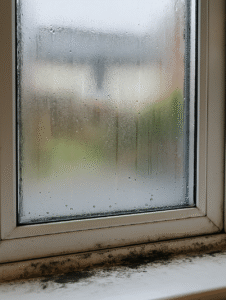 If you notice mould growth on walls, internal doors, or window frames, it’s likely due to excessive humidity and poor ventilation.
If you notice mould growth on walls, internal doors, or window frames, it’s likely due to excessive humidity and poor ventilation.
This is more than just a cosmetic issue. It’s a health hazard.
It can cause a skin rash, asthma flare-ups, respiratory issues, and irritation to the eyes and nose. The damp, excess moisture also encourages bacteria and can trigger allergies in children and elderly residents.
Beyond health issues, it can also damage your home.
Mold harms your home’s structure by eating away at building materials such as wood and drywall. It also traps moisture, which can lead to wood rot and crumbling, weakening the house over time. Plus, mold can stain and damage your furniture, carpets, and paint, making them look bad and smell musty.
The worse bit? Once mould embeds itself in walls or soft furnishings, cleaning alone won’t fix it.
In this sense, prevention is easier and cheaper than repair.
Damage to Frames and Sills
When condensation inside windows persists, excess water vapour seeps into surrounding materials. Over time, it leads to rotting wooden frames, warped uPVC windows, and broken or brittle window seals.
This kind of structural damage can spread beyond the window itself, requiring full window replacements and even repairs to interior plaster and sills.
In Stamford’s older homes, this can be particularly disruptive and expensive, especially if the property has decorative trims or heritage finishes.
Higher Energy Bills
If your double-glazed unit is compromised, it no longer provides proper thermal performance.
The result?
- – Higher levels of heat loss — especially in winter
- – Higher energy bills as your central heating works has to work harder
Think of it like this.
If your home still has single-glazed windows, you’re missing out on the energy efficiency that A-rated double glazing provides. This lack of insulation can add at least £150 a year to your energy bills, just through heat loss alone.
When you see condensation between the panes, this means your double glazing has blown. It’s now acting like a single glazed window. So you’ll be paying at least £150 a year extra in heating bills.
That’s not to mention the costs associated with replacing furnishings or fixing structural issues due to mould.
Over time, the cost of heating a home with condensation-prone windows far outweighs the cost of a new, energy-efficient one. And if you’ve got multiple blown double-glazed windows, that impact is multiplied.
Poor Comfort and Air Quality
Misted windows, foggy glass, and that constant chill in the air can make your home feel drafty, damp, and cold.
These aren’t just visual nuisances. They affect your day-to-day life.
Poor air circulation, rising humidity levels, and noise penetration through poorly sealed windows all add up.
You’ll notice more condensation on your bedroom windows, higher indoor humidity, and a home that just never feels truly warm or dry.
Lower Property Value
Potential buyers spot condensation from windows immediately.
It sends a clear message: the home has been poorly maintained or has outdated window technology.
This puts buyers off and can lower your sale price.
In Stamford’s competitive housing market, properties with modern double-glazed windows and good energy efficiency are far more appealing.
By contrast, homes with visible condensation issues often require buyers to budget for full window replacement. And they’ll negotiate accordingly.
Suffering from Condensation? New Windows Are the Smart Fix
Replacing old units with modern windows is the only way to permanently eliminate condensation from broken seals or poor insulation.
If you don’t want condensation, new windows are a must.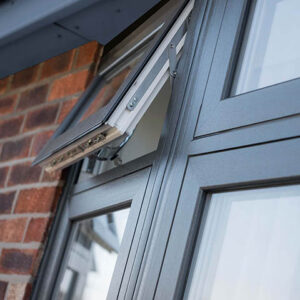
But how do new windows help deal with condensation?
- – A-rated windows maintain a stable internal temperature, reducing the chance of condensation forming
- – New glazed units include argon gas glass for insulation
- – Emissivity coatings improve performance
- – Frames include ventilation options like trickle vents for better air circulation
But it’s not just the fix for condensation new windows bring. There’s also a bunch of other benefits of updating your window technology…
- – Lower energy bills thanks to improved thermal efficiency
- – Better sound insulation
- – Cleaner, clearer views with no more foggy windows
- – Improved safety with stronger casement windows and external doors
- – Boosted kerb appeal with custom window installation
With Stamford’s mix of heritage homes and modern builds, it’s vital to choose efficient glass units that match your property’s character and reduce condensation on your windows.
If you’re not sure which windows best fit your budget, style, and requirements, don’t worry. Aperture Window Group is here to help. Simply book a callback in the form below.
Why Stamford Homeowners Choose Aperture Window Group
We’re not just a window installer. We’re a treasured part of the Stamford community.
With decades of experience installing windows in Stamford, we know what our clients need.
As the most trusted Stamford window fitters, Aperture Window Group offers:
- – Expert window fitters who understand local architecture and planning rules
- – Quality double-glazing products tailored to Stamford’s varied housing stock
- – A wide choice of glazing options, including double and triple glazing
- – A vast range of window options, including aluminium windows, uPVC, and hardwood
- – Honest, competitive quotes with 10- or 15-year guarantees on most installations
- – A track record of customer satisfaction across Stamford and the surrounding villages
Whether you need to replace one blown double-glazed window or you need a full window replacement, our team delivers high-performance, condensation-resistant solutions with minimal disruption.
Ready to Ditch the Damp?
Still staring at condensed windows each morning? Book your FREE, no-obligation quote today with Aperture Window Group. Simply fill in the form to book a callback at a time that suits you.
We’ll inspect your current windows, explain the cause of the issue, and provide a bespoke quote that suits your home and budget.
With modern window frames, efficient windows, and expert advice, we make your home feel warmer, drier, and clearer all year round.
Just fill out our 30-second online contact form to get started and enjoy a home that’s free from condensation, mould, and wasted heat.



